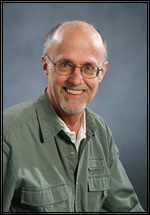2009 ISCB Accomplishment by a Senior Scientist Award Winner - Webb Miller
 |
|
Picture: 2009 ISCB ASSA Winner, Webb Miller
|
Ten years ago, Webb Miller was already well known to bioinformaticians worldwide for two very highly cited classic papers on the BLAST algorithms for searching sequence databases. Today Miller's name is equally well known for the alignment, comparison, and analysis of complete vertebrate genomes. Much of the code written in his group is embedded in the University of California Santa Cruz (UCSC) Genome Browser.
Miller's initial training was in mathematics. In the mid-1960s, at Whitman College in Walla Walla, Washington, he found a book in the library on the theoretical limits of what is computable, and he decided that he could undertake real, publishable research in this field. This led to graduate work in Computer Science, to his Ph.D. in Mathematics, and, by 1969, to an assistant professorship in Computer Science at The Pennsylvania State University (Penn State). At this time he still had no experience of practical computing or writing code.
In 1980, Miller was looking around for new challenges and applications of his computational knowledge. He found them through a most unexpected source. "My mother started sending me newspaper clippings about the beginnings of the Human Genome Project," he says. "This fascinated me, although I knew no biology at the time."
Soon after entering bioinformatics, Miller turned his attention from general sequence alignment algorithms to the specific problem of aligning long DNA sequences. "Most bioinformaticians spent the 1990s waiting for the human genome sequence," he said. "My question was: How soon would the second vertebrate genome come out, so I could try a genome-wide sequence alignment?" That second genome—of the mouse—was published in 2002. "I originally anticipated that we would have two vertebrate genomes by the time I reached retirement age in 2008. Instead, thanks to improvements in sequencing technology, we now have over forty."
He and his collaborators have now taken on a new challenge: sequencing the genomes and understanding the biology of rare, endangered, and even extinct species. He has published sequences of the nuclear genome of the woolly mammoth and the mitochondrial genome of the Tasmanian tiger (Thylacinus cynocephalus), which became extinct in 1936. Miller says he is hoping that similar sequencing techniques will help preserve endangered species from extinction. One of these is the so-called Tasmanian devil, a ferocious marsupial that is now under threat from a mysterious, contagious tumor: Devil Facial Tumor Disease. "We are sequencing two specimens, one with the disease and another that seems immune, and hope to use the differences to guide a breeding program," he says.
Miller acknowledges that he owes much of his success to "great" collaborators, from Gene Myers (Howard Hughes Medical Institute, USA) and David Lipman (National Cancer Biotechnology Information, USA) in the late 1980s to David Haussler (UCSC, USA) and Haussler’s colleagues Jim Kent and Tom Pringle. And it may be that great collaborators make each other. "Time and time again, Webb has made major contributions and taken little credit for himself, preferring to put younger researchers in the limelight, whether or not they were his students. I've never worked with a more generous collaborator," says Haussler.
In respect for his ISCB 2009 Accomplishment by a Senior Scientist Award, Miller offers his "10 Steps to Success in Bioinformatics" (click here).
This article is excerpted from the April 2009 issue of PLoS Computational Biology. To link to the full journal article please visit www.ploscompbiol.org/article/info:doi/10.1371/journal.pcbi.1000375.
